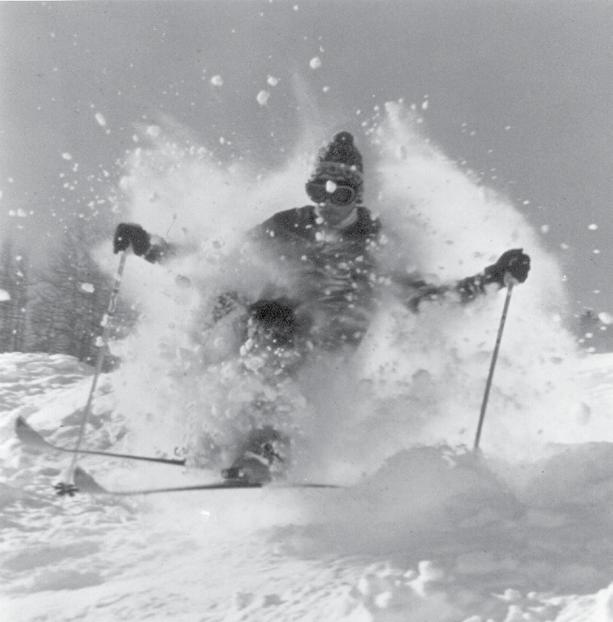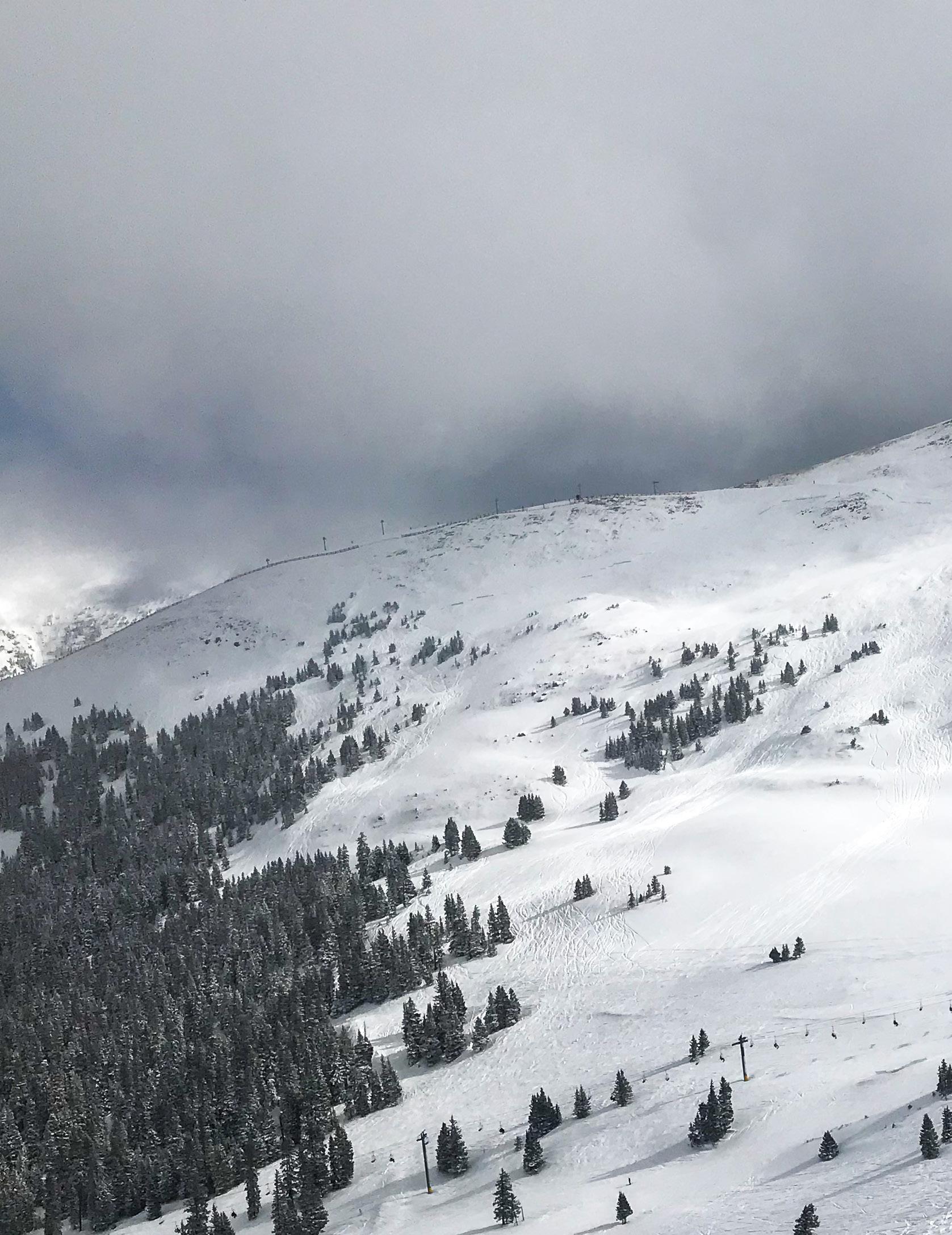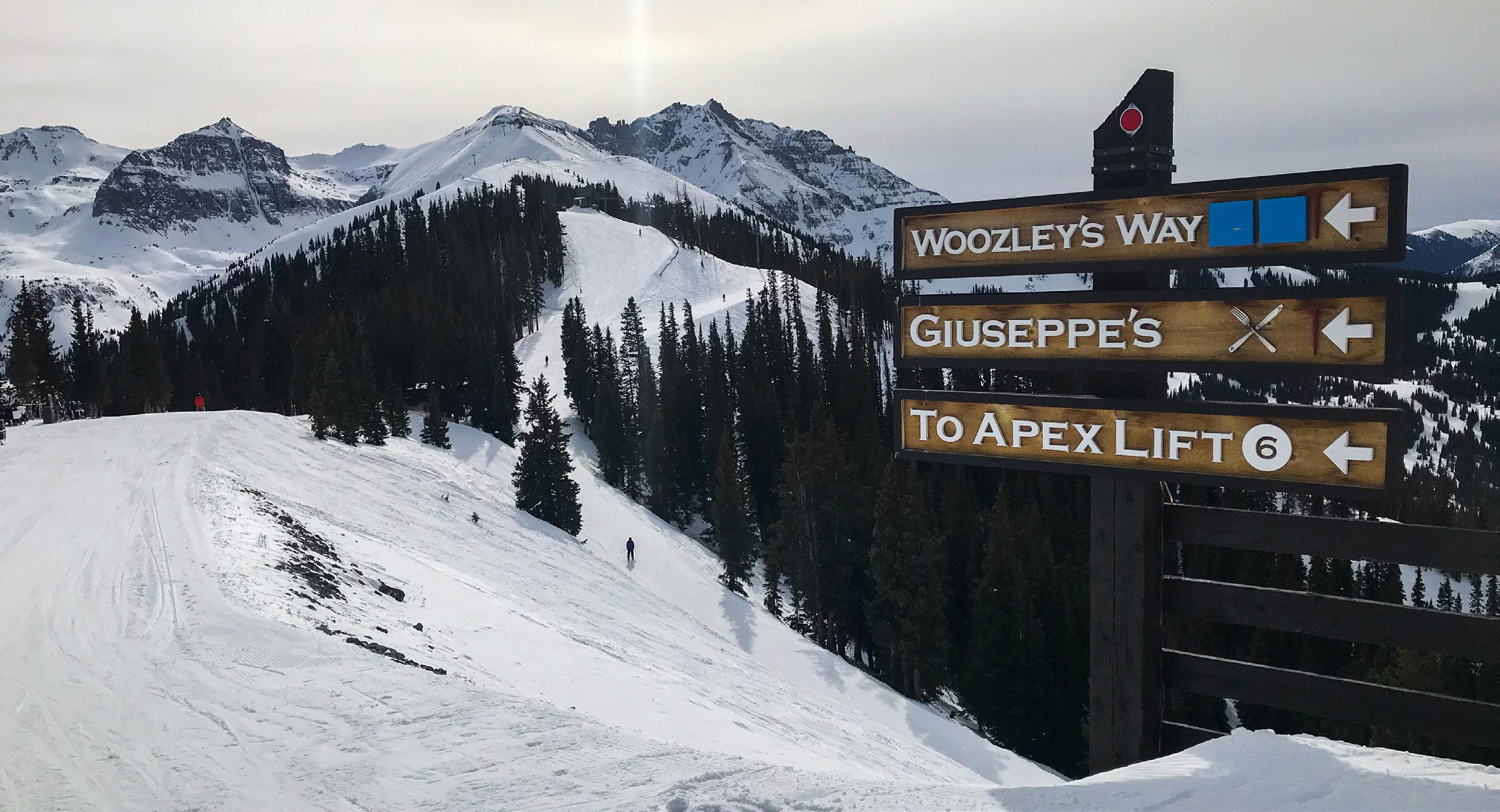
6 minute read
SKI AREAS
The early days of skiing. Enjoying powder stashes and solitude on the slopes of Purgatory Resort. photo courtesy of Purgatory Resort
A Return to Simplicity Ski areas shift their strategies heading into a COVID-stricken winter

BY TIONA EVERSOLE
The year is 2019. I settle into my seat on the chairlift at Purgatory Resort, my home mountain. My friends all laugh and crack jokes as we decide if we should stay on the front of the mountain, or head to the backside for a few laps. We take a couple of runs and stop for lunch and libations at the Powderhouse, sitting on the outside deck and enjoying the San Juan Mountain views. Live music plays, and others stop to take a break and converse with acquaintances on the deck.
On March 14, 2020, Purgatory Resort, along with every other ski area in Colorado, received notice of a government mandated order that would shut down operations for two weeks due to a rise in COVID-19 cases. This order would later be extended through April 6, and again to May 23. By this time, many ski areas are already closed for the season. The only exception to the shortened ski season was Arapahoe Basin, which opened from May 27 to June 9 with restricted capacity limits in place.
As ski areas gear up for a season unlike any other, snow sports enthusiasts are left wondering what winter will bring. With opening day comes a lot of updates and changes to existing protocols and procedures. And while every ski area is taking different approaches to comply with both local and state restrictions, one theme is certain: operations will be limited.
Limited operations may seem like a negative concept. Yet for those simply wishing to get out on the slopes, this very well could be the silver lining we didn't know we needed. ››
It’s not all that common to see empty slopes at Copper Mountain these days. photo by Tiona Eversole
THE GOOD ‘OL DAYS
Back before high-speed chairlifts and on-mountain dining, ski areas were just that: an area to get out and stretch your legs on the slopes. Hotels, retail stores and restaurants did not crowd the bottoms of lifts. Skiers enjoyed wide open runs with few crowds.
Howelson Hill in Steamboat Springs, Colorado, was the first ski area to open in the United States in 1915. Ski pioneer Carl Howelson, also known as the Father of Skiing in Colorado, built a ski jump at Howelson Hill that solidified a lifelong legacy of competitive skiing and ski jumping in the heart of ski country.
In the years following Howelson Hill’s opening, hundreds of resorts across the country would begin to operate — first with the introduction of ski rope tows in 1934 in Woodstock, Vermont, followed by the world’s first chairlift in 1936 at Sun Valley in Ketchum, Idaho. Crowds were few as the sport slowly began to catch on. In a report provided by the National Ski Areas Association (NSAA), the winter of 1978-1979 saw 15.8 million skier visits to areas in the Rocky Mountain region; whereas the winter of 2018-2019 received over 24 million skier visits.
Today, many ski areas offer a wide variety of winter activities (think tubing hills and snowmobile tours), lodging accommodations, multiple restaurants, shopping and even spa services. A plethora of offerings in turn attracts a wide range of individuals, some of which are not visiting to ski or snowboard.
Although the skiable terrain of these areas has expanded over the years, so has the total number of visitors to these locations. Busy periods such as the holidays and weekends exhibit packed trails and long lines to load the chairlift. The skiing experience of the past has dramatically shifted from a simple outdoor activity to an amusement park vibe.

A COVID-WINTER
This season, ski areas are tasked with developing new protocols and procedures to protect their guests from exposure to COVID-19. One of the biggest challenges is how these areas will regulate skier visits and capacity limits. Some entities such as Vail Resorts have chosen to implement a season pass holder reservation system. Others have opted to sell a limited number of daily lift tickets, or have implemented a parking reservation system to regulate the number of visitors to the mountain each day.
Aside from skier visits, indoor establishment capacity limits are another dilemma. Restaurants are looking for creative solutions to still provide guests with dining options while adhering to the new restrictions. Telluride Ski Resort, for example, is planning to convert up to 20 gondola cars into individual dining cabins. These refurbished structures will include lighting, heating and ventilation, and will provide additional dining options that are compliant with capacity restrictions. ››
Enjoying views from the top of Telluride Ski Resort. photo by Tiona Eversole

Skiing and snowboarding are already socially distant activities. It’s the parking lots, lift lines and indoor areas that visitors must take into consideration while resorts strive to adhere to new COVID procedures. photo by Tiona Eversole Other ski areas such as Purgatory Resort are looking to roll out online ordering options and indoor table limits.
Lessons and rentals have also provided their own specific sets of challenges, with possible solutions including smaller class sizes and reserved time slots to pick up rental equipment, to name a few.

WHY WE DO IT
Despite the uncertainties that surround COVID-19 and the new protocols being put into place by ski areas, one thing is certain: Our love to ski and snowboard.
The Center for Disease Control (CDC) states that outdoor activities with at least six feet of physical distance while wearing a mask are safe. Given that skiing and snowboarding already require a decent amount of distancing on the slopes, our favorite winter sports are generally a safe bet. Just remember to distance in the lift lines!
Sure, the aprés scene is always a good time complete with post-ride beers, laughter and friends; but in the age of COVID, things are different. Many of our favorite on-mountain bars and restaurants will not operate as they have before. Parking lot limitations will require us to rethink our tailgating prior to heading to the lifts. And times when we normally take a break and stop to socialize with our friends are now highly discouraged to prevent the spread of illness.
This year, we are reminded that the ski experience we’ve come to know and love must be put on hold for the greater good of those around us and the ski areas we visit. If they are shut down due to an outbreak, then we are the ones that miss out on those bluebird groomers and epic powder days. Ski areas were originally founded on the principle of getting out to enjoy the slopes. It’s time that we revisit this age-old concept and remind ourselves why we head for the hills on our days off in the first place. The time will come when we can resume our normal aprés antics, but for now — let’s just go ski.










